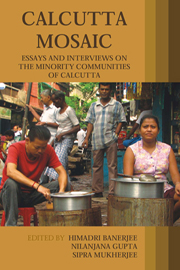Book contents
- Frontmatter
- Contents
- List of Contributors
- Acknowledgements
- Introduction
- 1 Mapping the Spaces of Minorities
- 2 The Armenians of Calcutta
- 3 The Jews of Calcutta: An Interview with Michael Ezra
- 4 The Sindhis of Calcutta
- 5 The City of Colleges
- 6 The Chinese Community of Calcutta
- 7 The Anglo–Indians of Calcutta
- 8 The Biharis of Calcutta
- 9 Agraharis of Calcutta
- 10 A Journey into My Neighbourhood
- 11 The ‘South Indians’ of Calcutta: Experiences in Cultural Processes
- 12 ‘Non-Bengali’ Icons of Malevolence
- 13 Selfing the City
7 - The Anglo–Indians of Calcutta
An Interview with Rudolph L Rodrigues
Published online by Cambridge University Press: 05 March 2012
- Frontmatter
- Contents
- List of Contributors
- Acknowledgements
- Introduction
- 1 Mapping the Spaces of Minorities
- 2 The Armenians of Calcutta
- 3 The Jews of Calcutta: An Interview with Michael Ezra
- 4 The Sindhis of Calcutta
- 5 The City of Colleges
- 6 The Chinese Community of Calcutta
- 7 The Anglo–Indians of Calcutta
- 8 The Biharis of Calcutta
- 9 Agraharis of Calcutta
- 10 A Journey into My Neighbourhood
- 11 The ‘South Indians’ of Calcutta: Experiences in Cultural Processes
- 12 ‘Non-Bengali’ Icons of Malevolence
- 13 Selfing the City
Summary
The Anglo-Indian community has been most visible in the schools and offices of Calcutta. During the colonial age, viewed by the colonizers either as bulwarks of the colonial elites, or as lurking threats to their power, they were subject to a ‘frequently shifting set of criteria that allowed them privilege at certain historical moments and pointedly excluded them at others’. Scholars have argued that, with the growth of ‘scientific racism’ in nineteenth century Europe, a transformation occurred in the relationships between the British rulers and the Anglo-Indians – ‘the “hybrid” became a trope for moral failure and degeneration, and led to the increasingly negative evaluation and status abasement of Anglo-Indians by British elites in India’. The introduction of technologically modern areas of occupation like the railways and telegraph in India gave the Anglo-Indians a specific social niche of their own. Many of them found jobs in these industries which were entirely new and therefore, unlike almost all other professions practised in India, had no caste identified with it. Their awareness ‘of themselves as distinct from the surrounding Indian population, with a common language (English) and a common religion (Christianity), as well as other shared cultural attributes’ encouraged them to keep themselves to the central parts of the city, where the schools and churches were. In recent years, though, the rising real estate prices have compelled them to move to outlying suburbs of the city, like the Andul and Metiabruz areas.
- Type
- Chapter
- Information
- Calcutta MosaicEssays and Interviews on the Minority Communities of Calcutta, pp. 143 - 152Publisher: Anthem PressPrint publication year: 2009



